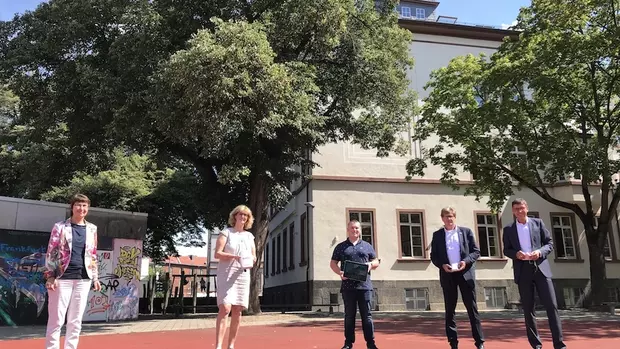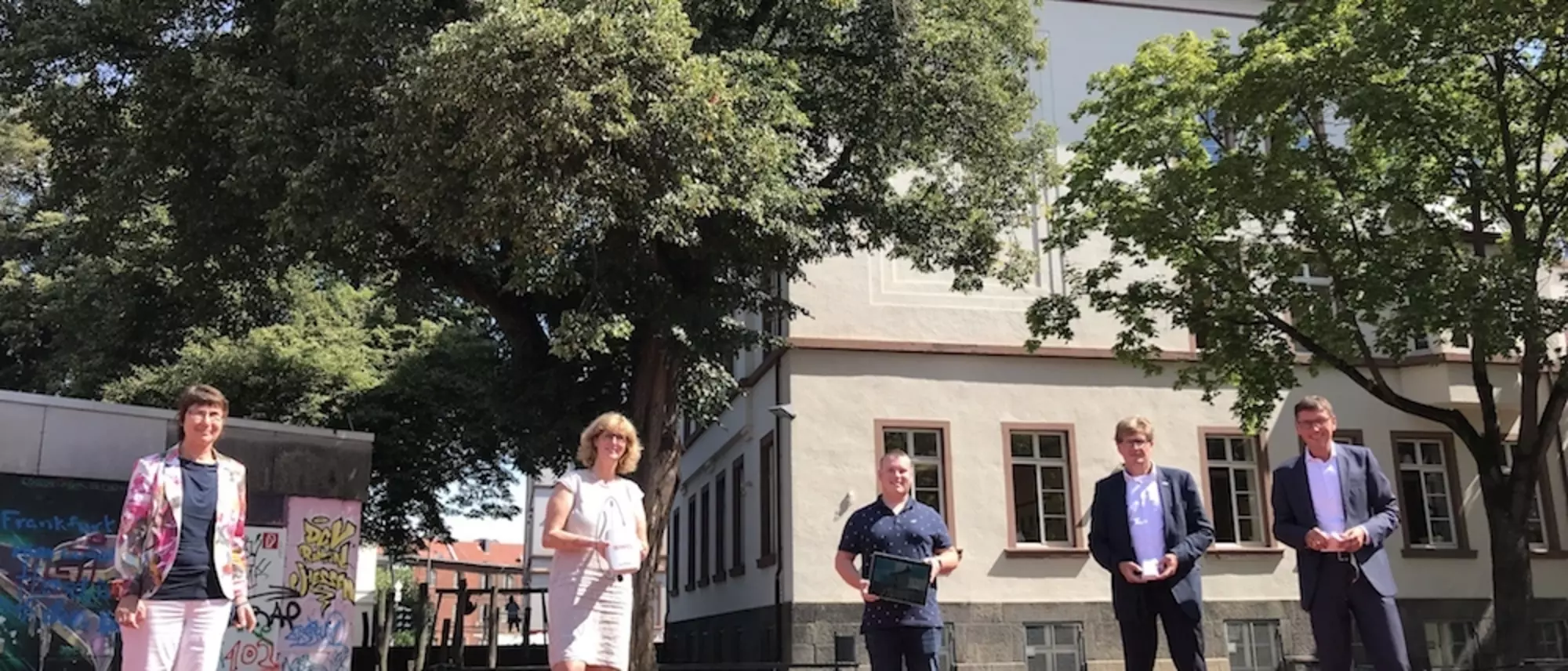
Long Range Wide Area Network, LoRaWAN for short, offers enormous potential for commerce, industry and local authorities. This is why Giessen's municipal utilities have been experimenting with this technology for some time. In the next few months, the city centre area is to be covered with LoRaWAN.
What is theCO2 content of the air in the sports hall? What is the room temperature? And what about the humidity? The caretaker and building manager of the Goethe School now receives this and other data on his computer in a clearly organised format. Supplied by Stadtwerke Gießen (SWG). The cooperation with the building department of the university city of Giessen is one of four pilot projects with which SWG is testing the possible applications of a Long Range Wide Area Network (LoRaWAN).
"Our initial experiences confirm our decision to rely on high-performance wireless technology," explains Jens Schmidt, Commercial Director of SWG. In fact, many useful applications are conceivable with LoRaWAN. Take the Goethe School, for example. Here, sensors monitor whether the sports hall is in use and whether its access door is open or closed. The temperature and humidity of a potentially damp workroom in the basement are constantly monitored. "These two parameters provide information on whether mould could form," says Matthias Funk, Technical Director at SWG, explaining the benefits. "And if you know the condition, you can remedy it." In this case by simply airing the room.
Monitoring theCO2 content of the air in the sports hall serves a very similar purpose. Important to know: The proportions of aerosols andCO2 in the air develop in parallel. A lot ofCO2 therefore means a lot of aerosols. Measuring the tiny particles dispersed in the air directly would be much more complex. "Regular, sufficient air exchange is currently a key issue when it comes to aerosols," says Matthias Funk. Not just because of corona. Fresh, drier air can be heated with less energy than humid air. In this respect, the hourly checks of the indoor climate should also improve energy efficiency.
SWG has also installed LoRaWAN transmitters on all electricity, district heating and water meters at the Goethe School. Here, too, the data is transmitted hourly. The findings derived from this ensure transparency in terms of consumption. Furthermore, the automatic recordings improve and simplify the current manual readings carried out by the caretakers for the city of Giessen's energy management. Smoke detectors in the ventilation system round off the complete package. The wireless technology also eliminates the need for complex wiring of the sensors. "Many useful applications of LoRaWAN can be demonstrated in this one property alone," says Astrid Eibelshäuser, Chairwoman of the SWG Supervisory Board. "I can well imagine that the city of Giessen will set up further similar projects with SWG."
Beginnings in-house
Before SWG approached the city and the Goethe School, they had already tested the technology in their own company. For example, all the district heating meters installed on the Lahnstraße site send their data to the server for processing every hour. But not only the consumption data, but also other information that is particularly important for the engineers - such as the temperatures of the supply and return pipes.
In the SWG customer centre on Marktplatz, sensors report the current number of people in the rooms. At the moment, of course, this is specifically used to control visitor flows and ensure that only as many people are standing in front of the counters as the authorities currently allow. In the long term, however, such counts harbour much more potential - for many other companies too. After all, if you know how many customers usually come and when, you can adapt much better. And adapt opening hours or staff planning accordingly, for example.
The fourth pilot project deals with the issue of car park management. SWG is monitoring the occupancy of the two parking spaces at its e-charging station in the car park opposite SWG's head office in Lahnstraße. "At the moment, we are still testing the reliability of the sensors. But the initial analyses make us very optimistic," says Fabian Fischer, project manager at SWG. The IT specialist for system integration was involved in setting up the test systems as part of his training project for his final examination. He is now employed by SWG and is the company's first dual student. As such, he will continue to drive forward the topic of LoRaWAN.
What is behind LoRaWAN
A LoRaWAN basically consists of three components: sensors that collect and send data, receivers - so-called gateways - that forward this data via the internet, and a server that processes the collected information. "This processing is an elementary component," adds Fabian Fischer. Because only intelligent visualisation of the data makes it possible to draw meaningful conclusions from it. Or to set certain processes in motion. There is a fourth group of components for this, the so-called actuators. For example, they start the water supply for an irrigation system when the moisture in the soil falls below a defined value. Or ensure automatic ventilation whenCO2 levels are too high by opening motorised windows - and closing them again when there is enough fresh air in the room.
"LoRaWAN offers enormous potential," Matthias Funk continues. The fact is that countless sensors and actuators are already available for a wide range of applications. For example, for farmers who want to track nitrogen levels in their soil. Logistics companies could use LoRaWAN to record the available capacity in warehouses. There are even special combined sensors for beehives that measure various parameters. The information collected in this way enables beekeepers to assess what is happening in the hives without disturbing their colonies.
Network for pouring
Because the use of LoRaWAN is so versatile, those responsible at SWG have decided to set up a network for Giessen city centre. Seven gateways are sufficient for this. They provide such good coverage that there are always at least three within range for the sensors from practically every point. This ensures the necessary reliability. SWG is also cooperating with the city of Giessen on the installation of these receiver modules. "We are allowed to use some municipal properties to install the gateways," says Fabian Fischer, explaining the collaboration.
There are practically no spatial restrictions for the locations of the sensors and actuators. The transmission even works from basements with comparatively thick ceilings - such as in the Goethe School. Not even a power supply is necessary because the devices work on batteries. And for a very long time. This is because they only transmit their data at specific, previously defined intervals. In addition, the required transmission power is extremely low - it is significantly lower than that of a smartphone.
Of course, SWG is also setting up the LoRaWAN to use it itself. For example, all district heating meters are to be gradually equipped with appropriate sensors for remote transmission. This will make meter reading much more efficient. SWG is also making this new infrastructure available to all other commercial or municipal interested parties. "Not only do we open up our network, but we also provide useful and useful visualised evaluations for the individual applications," says Jens Schmidt, describing the offer. If there are enquiries from outside the city centre area, SWG will check whether and how a connection is possible. "We intend to expand our network in line with demand," announces Jens Schmidt.
LoRaWAN could therefore make Giessen a little smarter in the future. And more efficient. Because on the way to becoming a climate-neutral municipality, one thing is needed above all else in addition toCO2-free energy: transparency when it comes to energy consumption. And this is precisely where LoRaWAN could play a key role.

